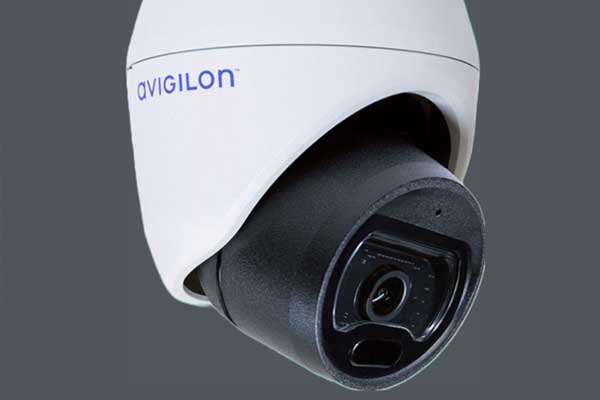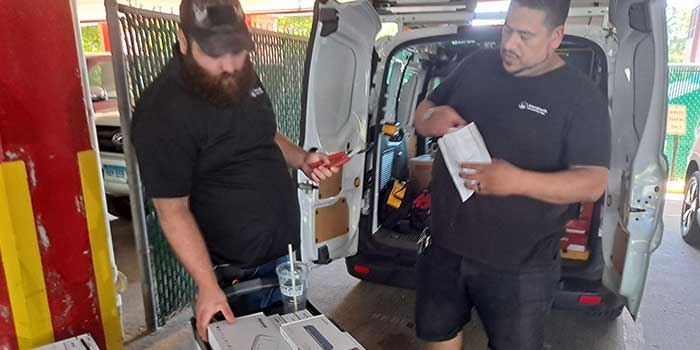Video MGMT System
 Access Control
Access Control
Voice & Data Wiring
 Burglar Alarm
Burglar Alarm
 Fire Alarm
Fire Alarm
Video MGMT System
Voice & Data Wiring
No time to read? Here’s a summary:

Wireless security cameras have become increasingly popular due to their easy installation and flexible placement options. But how exactly do these cameras work?
First, it's crucial to understand the key components of a wireless security system. These typically include a camera, a transmitter, a receiver, a monitor, and a recording device.
The camera captures the video feed. Modern wireless security cameras are often equipped with high-resolution capabilities, night vision, and motion detection, enabling them to capture high-quality video footage in various conditions.
Attached to the camera, the transmitter sends the video feed wirelessly. This is usually done over Wi-Fi, but some models might use other wireless protocols.
The receiver is typically connected to a monitor or recording device. It receives the transmitted signal from the camera and converts it into video footage.
The monitor displays the video received from the receiver. In most cases, this will be a computer or a smartphone screen where the user can view the footage in real-time.
This could be a DVR, NVR, or the cloud where the video footage is stored for future reference.

Once a wireless camera captures footage, the transmitter compresses and transmits its data wirelessly.
The receiver, connected to a recording device or monitor, receives this compressed data, decompresses it, and transforms it back into viewable footage.
Wireless security cameras primarily use two types of signals to transmit data:
Many wireless security cameras operate using radio frequencies to transmit video and audio signals. The most common frequency ranges for these devices are 2.4 GHz and 5 GHz, similar to the frequencies used by many Wi-Fi routers.
Wi-Fi signals are the most popular method used by modern wireless security cameras for data transmission. The camera connects to a Wi-Fi network and transmits the captured footage over this connection to a receiver, typically a router or a cloud-based server.
Wi-Fi allows for remote access, which means you can view the footage from anywhere as long as you have an internet connection.
Some wireless security cameras also support the use of cellular networks for transmitting data, particularly useful in locations where Wi-Fi connections may not be reliable or available.
It's worth noting that the type of signal used for data transmission can impact the camera's performance, including its range, video quality, and susceptibility to interference.
Always consider your specific requirements and the environment where the camera will be placed before choosing a wireless security camera.
While wireless systems are undoubtedly convenient, they are not always the best choice for every situation. Hardwired security camera systems, despite requiring more effort to install, often outperform wireless systems in several key areas.
Hardwired systems are not susceptible to signal interference or loss, which can be a common issue with wireless systems. Their direct connection means a consistent and reliable data stream, ensuring that your security coverage remains uninterrupted.
As hardwired systems don't need to compress video data for transmission, they can support higher-resolution cameras and offer superior video quality. This can make a significant difference when identifying details in footage, such as faces or license plate numbers.
Hardwired systems tend to be more scalable, making them an excellent choice for large properties or businesses. They can support more cameras without worrying about Wi-Fi congestion or signal degradation that can occur with wireless systems when too many devices are connected.
While wireless cameras transmit data over Wi-Fi, they can be vulnerable to hackers. On the other hand, hardwired systems provide a greater level of security, as physical access to the system is usually required to tamper with the data.
Finally, hardwired systems generally require less maintenance than wireless ones. They don't depend on batteries that need replacing, nor are they prone to signal issues that may require troubleshooting.

When deciding between wireless or hardwired security systems, the nature of your property, your specific security needs, and your long-term plans should all be considered. Remember that while wireless security cameras offer the benefits of convenience and flexibility, hardwired systems prove to be more reliable, scalable, secure, and capable of delivering high-quality video.
At Mammoth Security, we offer both wireless and hardwired systems, and our team is ready to assist you in determining the perfect solution for your business. To schedule a free site survey, just fill out the form below.
NOT COMPLETELY SURE?
860-748-4292A wireless security camera is a device that captures video footage and transmits it wirelessly to a receiver. These cameras are popular due to their easy installation and flexible placement options.
A wireless security camera captures video, compresses it, and sends it wirelessly to a receiver, typically using Wi-Fi. The receiver then decompresses the data and converts it into viewable footage.
The main components of a wireless security system are a camera, a transmitter, a receiver, a monitor, and a recording/storage/management device.
A hardwired security camera is a device that captures video footage and transmits it to a receiver through physical cables. Hardwired cameras are known for their reliability and high-quality video.
Hardwired security systems offer greater reliability, higher-quality video, scalability, enhanced security, and lower maintenance costs compared to wireless systems.
Wireless security systems may experience signal interference or loss, reduced video quality due to data compression, and vulnerabilities to hacking. They also require a stable Wi-Fi connection to function effectively.
Yes, hardwired security systems generally require professional installation due to the complexity of running cables and setting up the system. However, this ensures a secure and reliable setup.
The choice between a hardwired and wireless security system depends on your specific needs. Hardwired systems offer superior reliability, video quality, and security, but they require professional installation and aren't as flexible in terms of placement as wireless systems.
While wireless security cameras are generally safe, they can be more vulnerable to hacking than hardwired systems because they transmit data over Wi-Fi. It's essential to use strong, unique passwords and keep your systems updated to enhance security.
Yes, wireless security cameras need a power source. While they transmit data wirelessly, they still require power, typically provided by a power cord or batteries.
Yes, hardwired security cameras can operate without an Internet connection. They send footage via physical cables to a recording device or monitor, allowing for offline use.
Hardwired security systems can typically support more cameras than wireless systems. The exact number depends on the specific system and its capabilities.
While hardwired security systems generally require less maintenance than wireless ones, regular checks, and cleanings are recommended to ensure the system is functioning optimally.
The lifespan of a hardwired security camera varies, but on average, it can last anywhere from 4-6 years. High-quality cameras and regular maintenance can extend this lifespan.